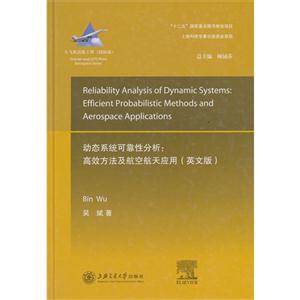-
>
公路車寶典(ZINN的公路車維修與保養秘籍)
-
>
晶體管電路設計(下)
-
>
基于個性化設計策略的智能交通系統關鍵技術
-
>
花樣百出:貴州少數民族圖案填色
-
>
山東教育出版社有限公司技術轉移與技術創新歷史叢書中國高等技術教育的蘇化(1949—1961)以北京地區為中心
-
>
鐵路機車概要.交流傳動內燃.電力機車
-
>
利維坦的道德困境:早期現代政治哲學的問題與脈絡
動態系統可靠性分析:高效方法及航空航天應用-(英文版) 版權信息
- ISBN:9787313101709
- 條形碼:9787313101709 ; 978-7-313-10170-9
- 裝幀:一般膠版紙
- 冊數:暫無
- 重量:暫無
- 所屬分類:>
動態系統可靠性分析:高效方法及航空航天應用-(英文版) 本書特色
《動態系統可靠性分析--高效方法及航空航天 應用(英文版)(精)/大飛機出版工程》編著者吳 斌。 《動態系統可靠性分析--高效方法及航空航天 應用(英文版)(精)/大飛機出版工程》針對動態 系統的可靠性分析,闡述了一種新的優化技術,即針 對低頻率諧 振動力載荷下的工程產品結構可靠性問題,使用綜合 的快速概率方法,也即“擾動 算法+蒙特卡洛方法”。在針對兩個航空航天實際工 程案例的應用中發現,運用此 方法能快速準確地解決失效面高非線性、大量計算強 度和動態系統高復雜度等原 有概率方法的應用困難。本書的出版填補了國際上對 高效快速概率方法的研究空 白。 本書可供從事民用飛機結構可靠性安全性工程設 計分析、試驗、管理的技術人 員和相關專業的研究生使用。
動態系統可靠性分析:高效方法及航空航天應用-(英文版) 內容簡介
《動態系統可靠性分析--高效方法及航空航天應用(英文版)(精)/大飛機出版工程》編著者吳斌。 本書根據作者在劍橋大學工程系可靠性專業多年研究成果和近幾年來在中國商飛公司民機研制的實踐經驗編撰而成,主要闡述了一種處理工程結構可靠性和安全性問題的綜合優化方法,即針對低頻率諧振動力載荷下的復雜的工程產品結構可靠性問題,使用綜合的快速概率方法。此方法旨在克服概率方法應用的困難,比如失效面的高非線性問題、大量的計算強度和動態系統的高復雜度等。這是在總結現有的各種分析方法的基礎上,提出的一種*新的基于非確定因素的概率分析方法,體現國際*新發展。
動態系統可靠性分析:高效方法及航空航天應用-(英文版) 目錄
dedication
preface
acknowledgments
nomenclature
list of figures
list of tables
1.introduction
1.1 structural reliability analysis
1.2 non-deterministic reliability analysis methods
1.2.1 monte carlo simulation (mcs) method
1.2.2 form (first-order reliability method)
1.2.3 interval analysis
1.2.4 fuzzy analysis
1.2.5 response surface method (rsm)
1.2.6 summary
1.3 uncertainty analysis of dynamic systems
1.3.1 background
1.3.2 literature review of analytical approaches to dynamic systems
1.3.3 summary
1.4 scope of the present work
1.5 overview of the book
2.technical background
2.1 definition of structural reliability
2.2 technical basis of the monte carlo simulation method
2.3 theory of the first-order reliability method (form)
2.4 response surface method
2.4.1 response surface models and fitting techniques
2.4.2 sampling design methods
2.5 problems of applying form and rsm methods to dynamic systems
2.5.1 problematic failure surfaces for form applications
2.5.2 inaccuracy of rsm in predicting the dynamic response
2.6 optimization solution through modal analysis
3.theoretical fundamentals of the perturbation approach
3.1 definition of the new parameters and safety margin
3.2 derivation of the two moments of the new parameters
3.2.1 derivation of the covariance matrix of the modal parameter w2
3.2.2 derivation of the covariance matrix of the defined parameter dr
3.2.3 derivation of the covariance matrix of the modal parameter [□]
3.2.4 derivation of the covariance matrix of the defined parameter rjk,r
3.2.5 derivation of the covariance matrix of the combined parameter t
3.2.6 derivation of the mean values of the defined parameters dr and rik,r
3.3 application procedure of the new approach
3.4 discussion
3.5 summary
4.application to a 2d system
4.1 finite element model of a 2d dynamic system
4.2 applying the combined approach: preliminary analysis
4.2.1 response analysis
4.2.2 safety margin contour
4.3 perturbation approach + form method
4.3.1 evaluating the probability of failure and in-depth analysis
4.3.2 solution 1: second-order approximation of d2
4.3.3 solution 2: new variable e2 to replace d2
4.3.4 solution 3: variable □ to replace e2
4.4 solution 4: monte carlo simulation replacing form
4.4.1 perturbation + monte carlo simulation on r2 and w□
4.4.2 reliability analysis of the updated combined approach
4.5 summary
5.application to a 3d helicopter model
5.1 background of helicopter vibration'control
5.2 a 3d helicopter ee model
5.2.1 system details
5.2.2 dynamic characteristics of the model
5.3 response analysis
5.4 reliability analysis of the combined approach
5.4.1 probability vs. excitation frequencies
5.4.2 probability vs. maximum displacement and variation coefficient
5.5 efficiency analysis
5.6 summary
6.complete combined approach
6.1 response surface techniques in obtaining ck
6.1.1 direct rs model fitting of the stiffness matrix k
6.1.2 alternative fitting approach
6.1.3 analytical approach to obtain the covariance matrix of k
6.1.4 complete combined approach
6.2 complete application to 2d frame model
6.2.1 type i rs model fitting with koshal design
6.2.2 complete combined approach
6.3 complete application to 3d helicopter model
6.4 summary
7.conclusions and future work
7.1 achievements and conclusions
7.2 future work
7.2.1 application of an enhanced form method
7.2.2 further simplification of perturbation/analytical algorithms
7.2.3 development for non-probabilistic methods
appendix ⅰ:transforming random variables from correlated to uncorrelated
appendix ⅱ:analytical solution of hl safety index
appendix ⅲ:modal analysis of dynamic systems
appendix ⅳ:multiple force analysis
appendix ⅴ:summary of the defined parameters
appendix ⅵ:nodal coordinates of the helicopter model
appendix ⅶ:element connectivity and properties of the
helicopter model
references
index
- >
羅庸西南聯大授課錄
- >
有舍有得是人生
- >
二體千字文
- >
月亮與六便士
- >
史學評論
- >
李白與唐代文化
- >
煙與鏡
- >
新文學天穹兩巨星--魯迅與胡適/紅燭學術叢書(紅燭學術叢書)
















